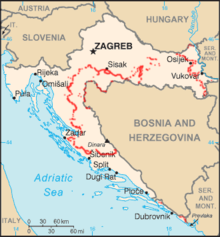Mine lock
A mine barrier (also minefield , mine carpet or mine belt ) is a limited area with laid, mostly self-releasing mines. It can be land mines under the surface of the earth or sea mines under the water surface. The mines are often laid in a certain pattern and with a certain density. The mine barriers are usually mapped and recorded in so-called mine barrier records so as not to pose a threat to their own troops and to enable the mines to be cleared quickly after the end of the war. However, this happens relatively rarely.
The mine barrier is a tactical barrier - depending on the requirements - either just the width of the street or several kilometers. A mine barrier, which is created at bottlenecks (e.g. between two lakes ), should make these bottlenecks impassable for the enemy. Large-scale mine barriers are created to secure an entire border or front and to restrict the enemy's freedom of movement. As a matter of principle, barriers are monitored and, in order not to hinder one's own troops, are ordered from the brigade level upwards, often only for a short period of time.
Lock with land mines
Mine barriers on land can consist of both anti-personnel and anti - tank mines (or anti - vehicle mines ) and, like all mine barriers, are of a defensive nature.
Anti-tank mines are laid in at least three rows behind one another at a distance of one to two meters with the mines offset. The distance between the mines is again one to two meters. The chance of driving through such a mine barrier undamaged is almost zero.
Pressure-sensitive anti-personnel mines are laid offset in several rows, the distance between the mines is max. one meter. If, on the other hand, the mine barrier is laid with tripwire-triggered spring mines , they are laid - depending on the shape of the terrain - at intervals of 20 to 30 meters.
One weapon that can be used to quickly lay mine barriers is the Skorpion mine throwing system used by the Bundeswehr . In a group of two, the system is able to create a barrier 3000 meters long and around 200 meters wide in twelve minutes.
A large-scale installation can also be done with airplanes.
See also
Individual evidence
- ↑ Central Service Regulation (ZDv) 15 Humanitarian International Law in Armed Conflicts - Handbook - [1] (PDF; 635 kB)
